International HRM: Cross-Cultural Differences in HR Practices Report
VerifiedAdded on 2023/06/10
|16
|3076
|58
Report
AI Summary
This report provides an in-depth analysis of cross-cultural differences within the realm of International Human Resource Management (IHRM). The report specifically examines the impact of cultural variations on crucial HR practices, including recruitment and selection, and training and development. It explores how these practices must be adapted to different cultural contexts to ensure organizational success, drawing upon various academic references and real-world examples to illustrate the complexities of managing a global workforce. The report delves into the influence of cultural dimensions, such as those outlined by Hofstede's model, on HR strategies, and how organizations can navigate these differences to optimize employee performance and achieve their global objectives. Furthermore, it highlights the importance of intercultural training and the challenges faced by multinational corporations in implementing consistent HR policies across diverse cultural landscapes. The report also explores internal and external recruitment, selection methods, and different approaches to IHRM, like ethnocentric, polycentric, regiocentric, and geocentric, to give a comprehensive understanding of the subject.
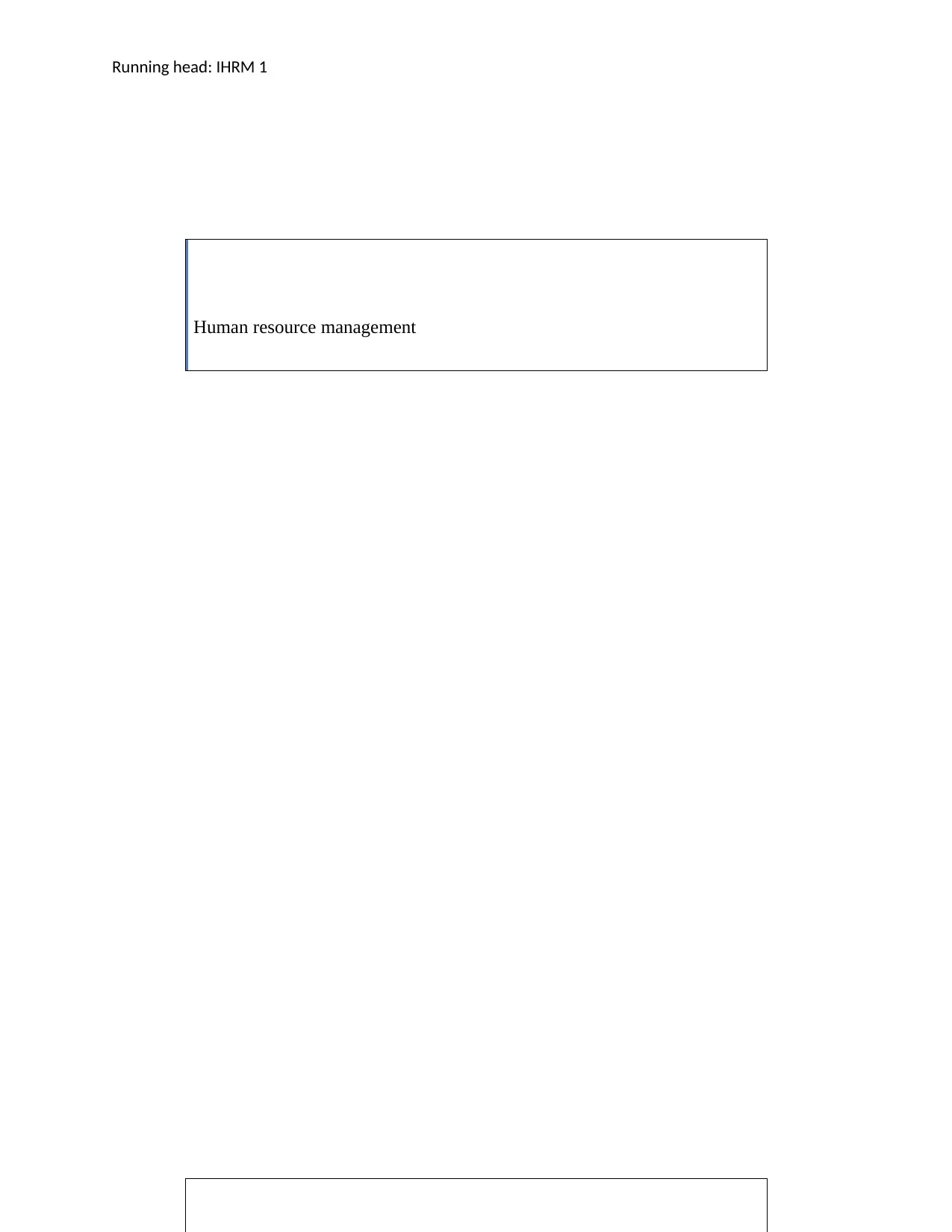
Running head: IHRM 1
Human resource management
Human resource management
Paraphrase This Document
Need a fresh take? Get an instant paraphrase of this document with our AI Paraphraser
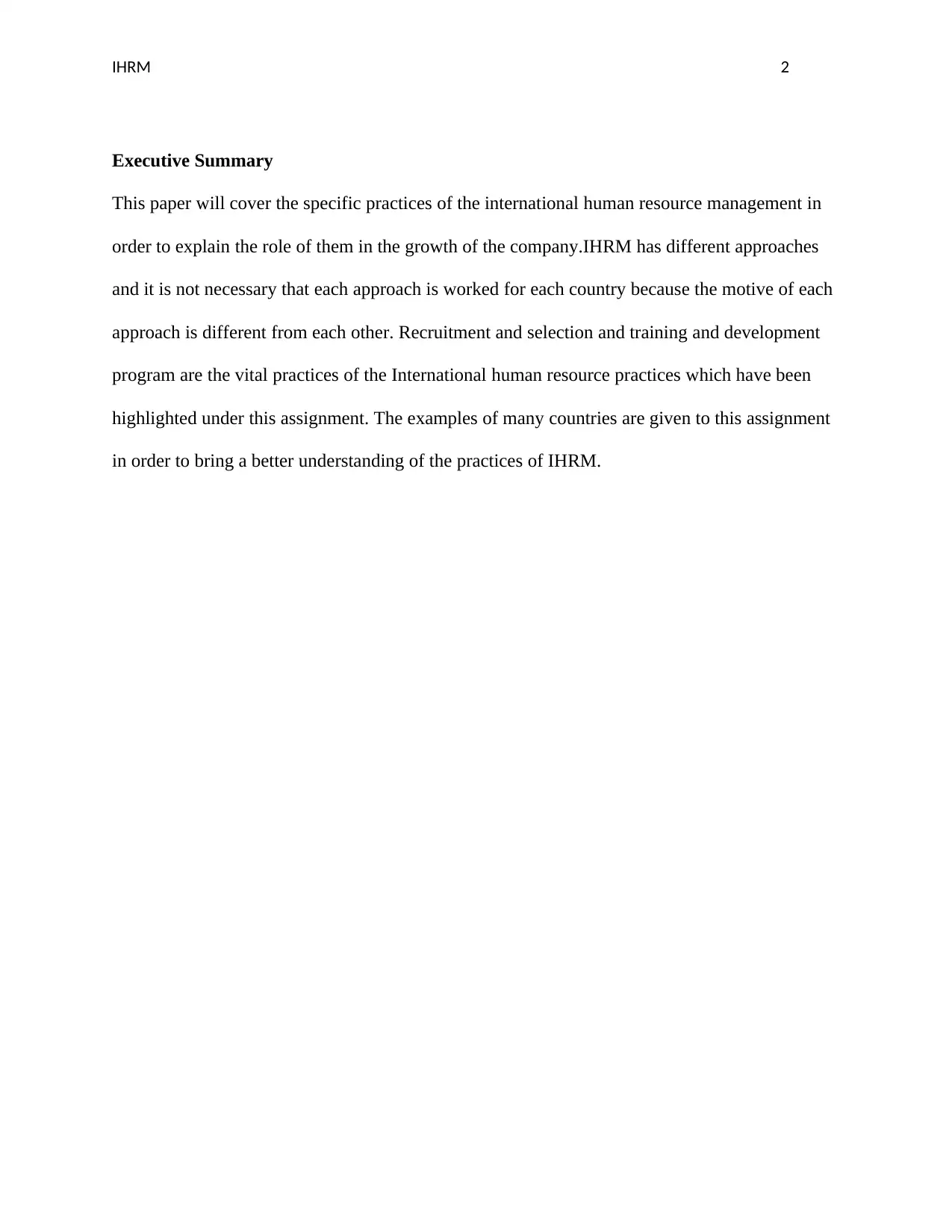
IHRM 2
Executive Summary
This paper will cover the specific practices of the international human resource management in
order to explain the role of them in the growth of the company.IHRM has different approaches
and it is not necessary that each approach is worked for each country because the motive of each
approach is different from each other. Recruitment and selection and training and development
program are the vital practices of the International human resource practices which have been
highlighted under this assignment. The examples of many countries are given to this assignment
in order to bring a better understanding of the practices of IHRM.
Executive Summary
This paper will cover the specific practices of the international human resource management in
order to explain the role of them in the growth of the company.IHRM has different approaches
and it is not necessary that each approach is worked for each country because the motive of each
approach is different from each other. Recruitment and selection and training and development
program are the vital practices of the International human resource practices which have been
highlighted under this assignment. The examples of many countries are given to this assignment
in order to bring a better understanding of the practices of IHRM.
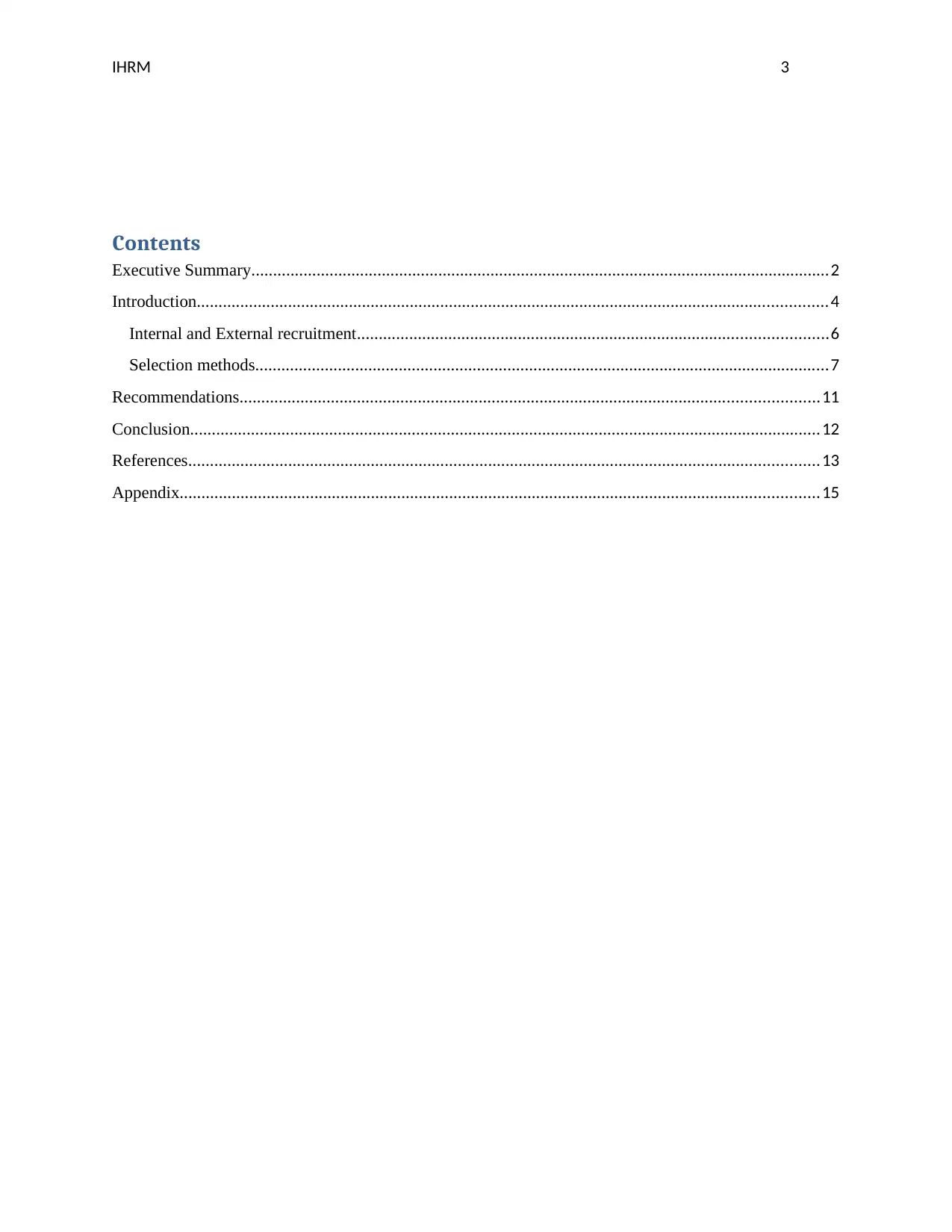
IHRM 3
Contents
Executive Summary.....................................................................................................................................2
Introduction.................................................................................................................................................4
Internal and External recruitment............................................................................................................6
Selection methods....................................................................................................................................7
Recommendations.....................................................................................................................................11
Conclusion.................................................................................................................................................12
References.................................................................................................................................................13
Appendix...................................................................................................................................................15
Contents
Executive Summary.....................................................................................................................................2
Introduction.................................................................................................................................................4
Internal and External recruitment............................................................................................................6
Selection methods....................................................................................................................................7
Recommendations.....................................................................................................................................11
Conclusion.................................................................................................................................................12
References.................................................................................................................................................13
Appendix...................................................................................................................................................15
⊘ This is a preview!⊘
Do you want full access?
Subscribe today to unlock all pages.

Trusted by 1+ million students worldwide
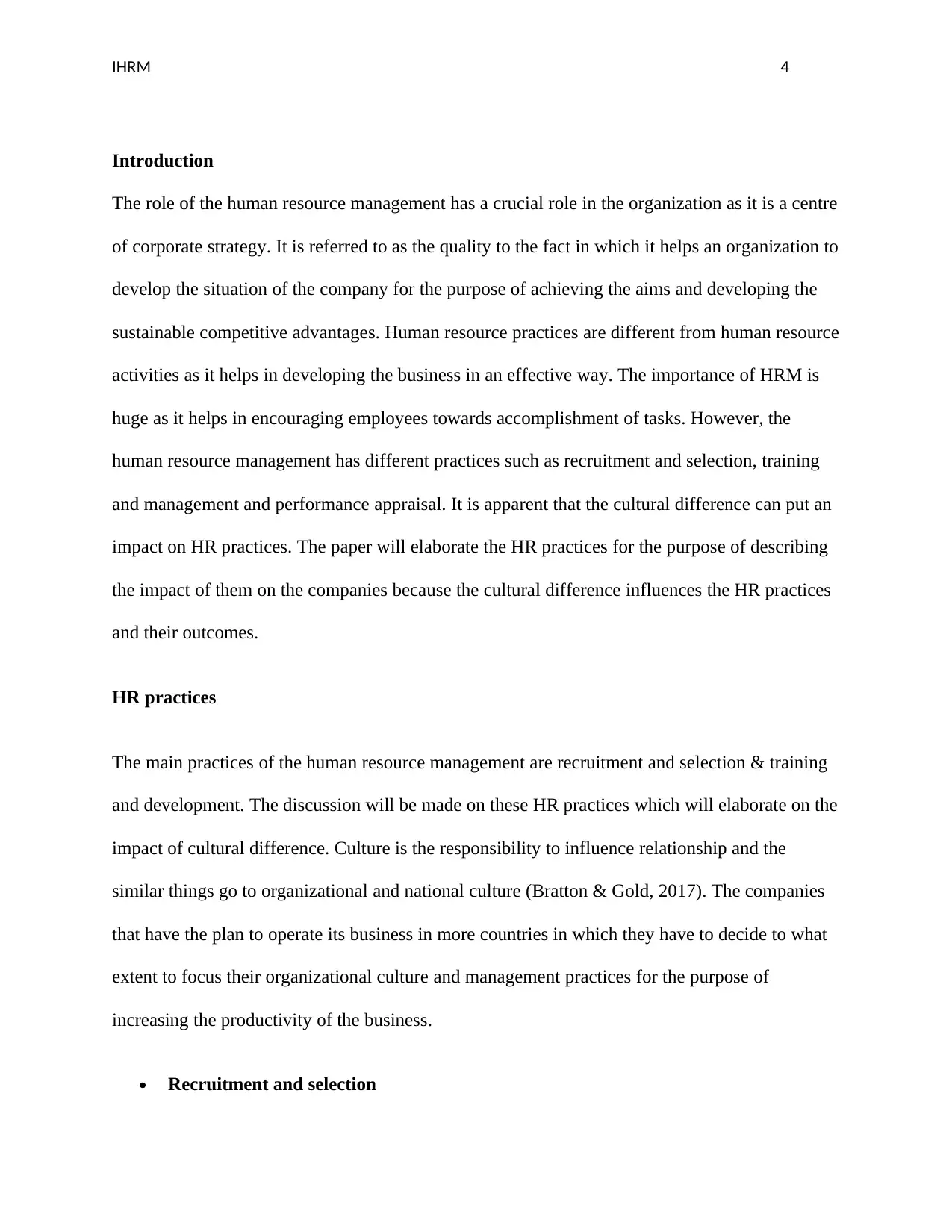
IHRM 4
Introduction
The role of the human resource management has a crucial role in the organization as it is a centre
of corporate strategy. It is referred to as the quality to the fact in which it helps an organization to
develop the situation of the company for the purpose of achieving the aims and developing the
sustainable competitive advantages. Human resource practices are different from human resource
activities as it helps in developing the business in an effective way. The importance of HRM is
huge as it helps in encouraging employees towards accomplishment of tasks. However, the
human resource management has different practices such as recruitment and selection, training
and management and performance appraisal. It is apparent that the cultural difference can put an
impact on HR practices. The paper will elaborate the HR practices for the purpose of describing
the impact of them on the companies because the cultural difference influences the HR practices
and their outcomes.
HR practices
The main practices of the human resource management are recruitment and selection & training
and development. The discussion will be made on these HR practices which will elaborate on the
impact of cultural difference. Culture is the responsibility to influence relationship and the
similar things go to organizational and national culture (Bratton & Gold, 2017). The companies
that have the plan to operate its business in more countries in which they have to decide to what
extent to focus their organizational culture and management practices for the purpose of
increasing the productivity of the business.
Recruitment and selection
Introduction
The role of the human resource management has a crucial role in the organization as it is a centre
of corporate strategy. It is referred to as the quality to the fact in which it helps an organization to
develop the situation of the company for the purpose of achieving the aims and developing the
sustainable competitive advantages. Human resource practices are different from human resource
activities as it helps in developing the business in an effective way. The importance of HRM is
huge as it helps in encouraging employees towards accomplishment of tasks. However, the
human resource management has different practices such as recruitment and selection, training
and management and performance appraisal. It is apparent that the cultural difference can put an
impact on HR practices. The paper will elaborate the HR practices for the purpose of describing
the impact of them on the companies because the cultural difference influences the HR practices
and their outcomes.
HR practices
The main practices of the human resource management are recruitment and selection & training
and development. The discussion will be made on these HR practices which will elaborate on the
impact of cultural difference. Culture is the responsibility to influence relationship and the
similar things go to organizational and national culture (Bratton & Gold, 2017). The companies
that have the plan to operate its business in more countries in which they have to decide to what
extent to focus their organizational culture and management practices for the purpose of
increasing the productivity of the business.
Recruitment and selection
Paraphrase This Document
Need a fresh take? Get an instant paraphrase of this document with our AI Paraphraser
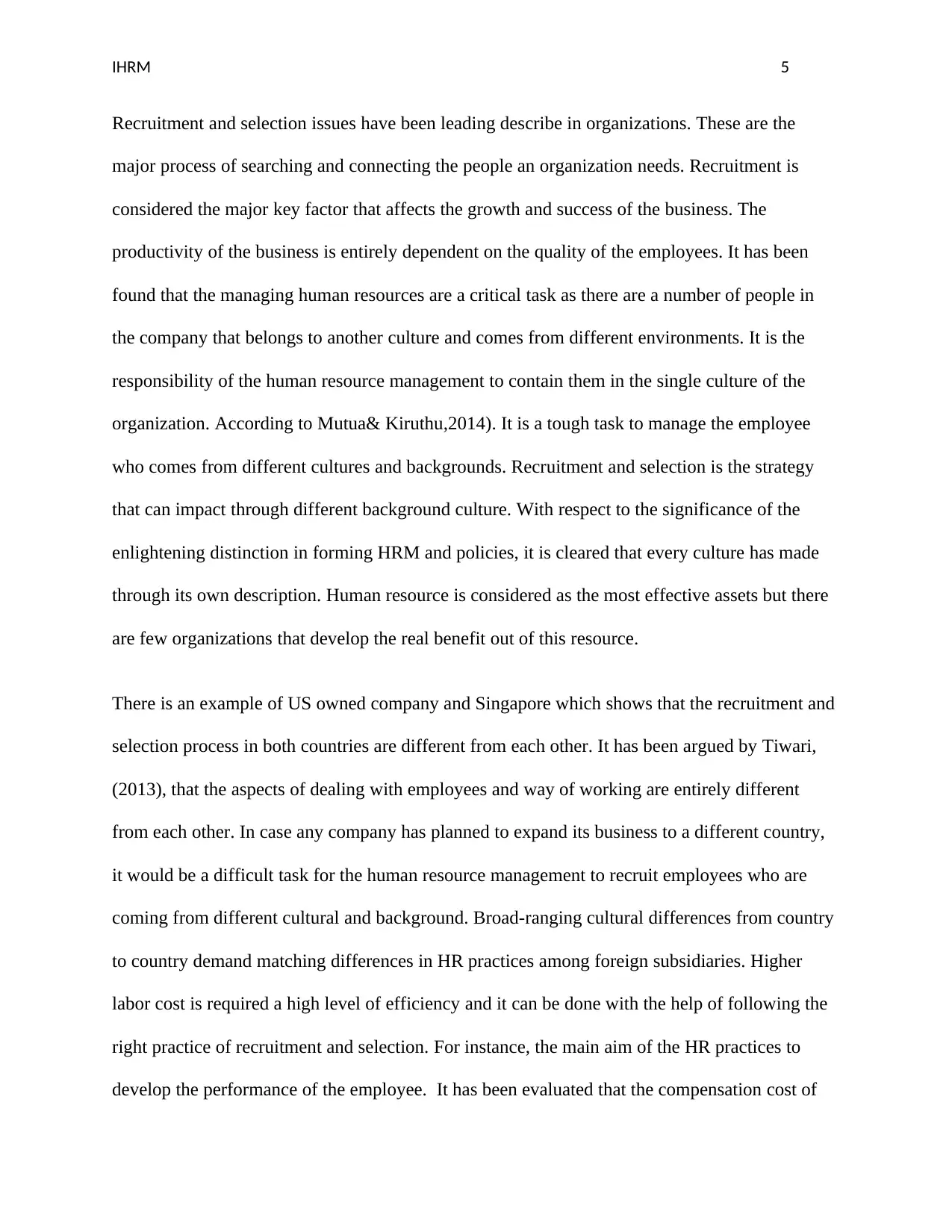
IHRM 5
Recruitment and selection issues have been leading describe in organizations. These are the
major process of searching and connecting the people an organization needs. Recruitment is
considered the major key factor that affects the growth and success of the business. The
productivity of the business is entirely dependent on the quality of the employees. It has been
found that the managing human resources are a critical task as there are a number of people in
the company that belongs to another culture and comes from different environments. It is the
responsibility of the human resource management to contain them in the single culture of the
organization. According to Mutua& Kiruthu,2014). It is a tough task to manage the employee
who comes from different cultures and backgrounds. Recruitment and selection is the strategy
that can impact through different background culture. With respect to the significance of the
enlightening distinction in forming HRM and policies, it is cleared that every culture has made
through its own description. Human resource is considered as the most effective assets but there
are few organizations that develop the real benefit out of this resource.
There is an example of US owned company and Singapore which shows that the recruitment and
selection process in both countries are different from each other. It has been argued by Tiwari,
(2013), that the aspects of dealing with employees and way of working are entirely different
from each other. In case any company has planned to expand its business to a different country,
it would be a difficult task for the human resource management to recruit employees who are
coming from different cultural and background. Broad-ranging cultural differences from country
to country demand matching differences in HR practices among foreign subsidiaries. Higher
labor cost is required a high level of efficiency and it can be done with the help of following the
right practice of recruitment and selection. For instance, the main aim of the HR practices to
develop the performance of the employee. It has been evaluated that the compensation cost of
Recruitment and selection issues have been leading describe in organizations. These are the
major process of searching and connecting the people an organization needs. Recruitment is
considered the major key factor that affects the growth and success of the business. The
productivity of the business is entirely dependent on the quality of the employees. It has been
found that the managing human resources are a critical task as there are a number of people in
the company that belongs to another culture and comes from different environments. It is the
responsibility of the human resource management to contain them in the single culture of the
organization. According to Mutua& Kiruthu,2014). It is a tough task to manage the employee
who comes from different cultures and backgrounds. Recruitment and selection is the strategy
that can impact through different background culture. With respect to the significance of the
enlightening distinction in forming HRM and policies, it is cleared that every culture has made
through its own description. Human resource is considered as the most effective assets but there
are few organizations that develop the real benefit out of this resource.
There is an example of US owned company and Singapore which shows that the recruitment and
selection process in both countries are different from each other. It has been argued by Tiwari,
(2013), that the aspects of dealing with employees and way of working are entirely different
from each other. In case any company has planned to expand its business to a different country,
it would be a difficult task for the human resource management to recruit employees who are
coming from different cultural and background. Broad-ranging cultural differences from country
to country demand matching differences in HR practices among foreign subsidiaries. Higher
labor cost is required a high level of efficiency and it can be done with the help of following the
right practice of recruitment and selection. For instance, the main aim of the HR practices to
develop the performance of the employee. It has been evaluated that the compensation cost of
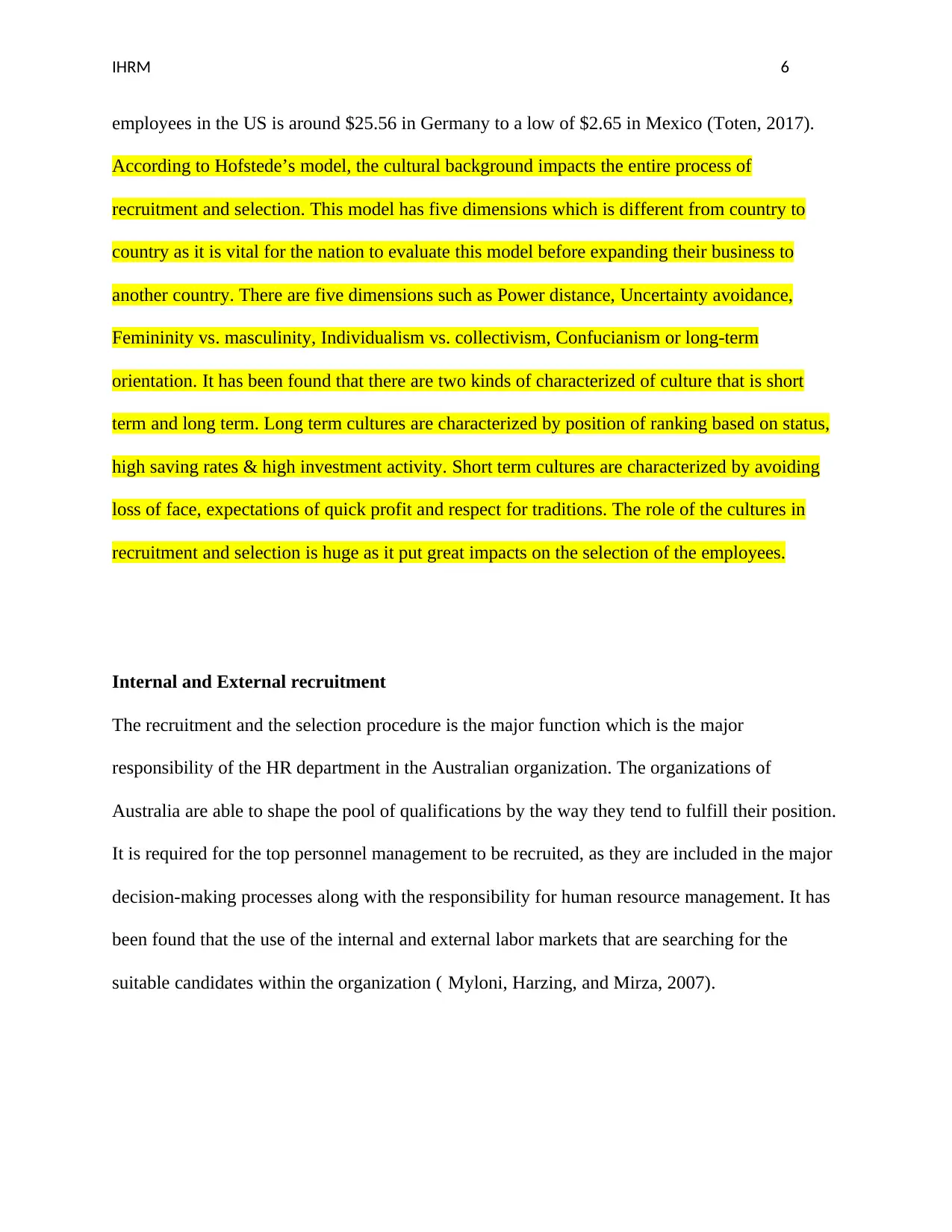
IHRM 6
employees in the US is around $25.56 in Germany to a low of $2.65 in Mexico (Toten, 2017).
According to Hofstede’s model, the cultural background impacts the entire process of
recruitment and selection. This model has five dimensions which is different from country to
country as it is vital for the nation to evaluate this model before expanding their business to
another country. There are five dimensions such as Power distance, Uncertainty avoidance,
Femininity vs. masculinity, Individualism vs. collectivism, Confucianism or long-term
orientation. It has been found that there are two kinds of characterized of culture that is short
term and long term. Long term cultures are characterized by position of ranking based on status,
high saving rates & high investment activity. Short term cultures are characterized by avoiding
loss of face, expectations of quick profit and respect for traditions. The role of the cultures in
recruitment and selection is huge as it put great impacts on the selection of the employees.
Internal and External recruitment
The recruitment and the selection procedure is the major function which is the major
responsibility of the HR department in the Australian organization. The organizations of
Australia are able to shape the pool of qualifications by the way they tend to fulfill their position.
It is required for the top personnel management to be recruited, as they are included in the major
decision-making processes along with the responsibility for human resource management. It has
been found that the use of the internal and external labor markets that are searching for the
suitable candidates within the organization ( Myloni, Harzing, and Mirza, 2007).
employees in the US is around $25.56 in Germany to a low of $2.65 in Mexico (Toten, 2017).
According to Hofstede’s model, the cultural background impacts the entire process of
recruitment and selection. This model has five dimensions which is different from country to
country as it is vital for the nation to evaluate this model before expanding their business to
another country. There are five dimensions such as Power distance, Uncertainty avoidance,
Femininity vs. masculinity, Individualism vs. collectivism, Confucianism or long-term
orientation. It has been found that there are two kinds of characterized of culture that is short
term and long term. Long term cultures are characterized by position of ranking based on status,
high saving rates & high investment activity. Short term cultures are characterized by avoiding
loss of face, expectations of quick profit and respect for traditions. The role of the cultures in
recruitment and selection is huge as it put great impacts on the selection of the employees.
Internal and External recruitment
The recruitment and the selection procedure is the major function which is the major
responsibility of the HR department in the Australian organization. The organizations of
Australia are able to shape the pool of qualifications by the way they tend to fulfill their position.
It is required for the top personnel management to be recruited, as they are included in the major
decision-making processes along with the responsibility for human resource management. It has
been found that the use of the internal and external labor markets that are searching for the
suitable candidates within the organization ( Myloni, Harzing, and Mirza, 2007).
⊘ This is a preview!⊘
Do you want full access?
Subscribe today to unlock all pages.

Trusted by 1+ million students worldwide
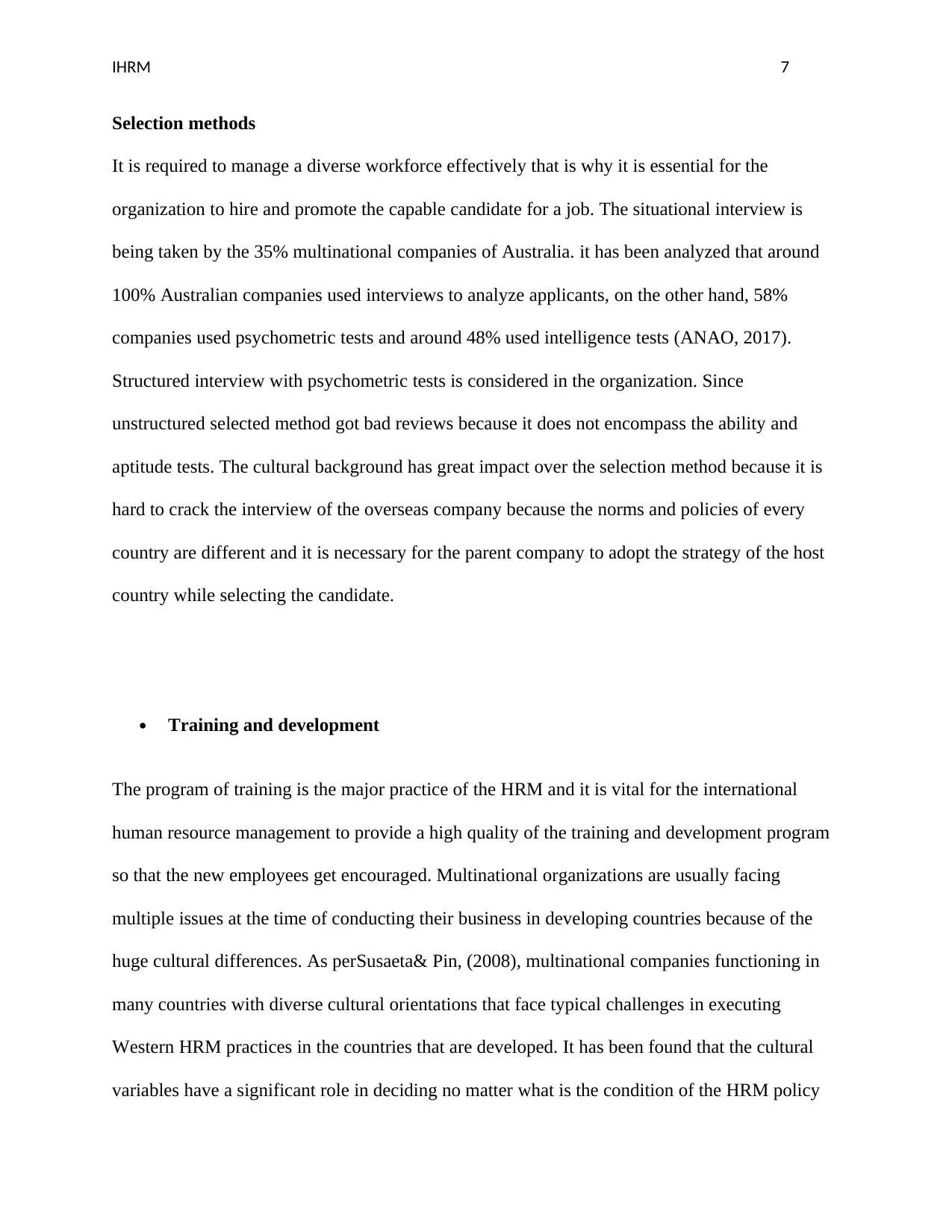
IHRM 7
Selection methods
It is required to manage a diverse workforce effectively that is why it is essential for the
organization to hire and promote the capable candidate for a job. The situational interview is
being taken by the 35% multinational companies of Australia. it has been analyzed that around
100% Australian companies used interviews to analyze applicants, on the other hand, 58%
companies used psychometric tests and around 48% used intelligence tests (ANAO, 2017).
Structured interview with psychometric tests is considered in the organization. Since
unstructured selected method got bad reviews because it does not encompass the ability and
aptitude tests. The cultural background has great impact over the selection method because it is
hard to crack the interview of the overseas company because the norms and policies of every
country are different and it is necessary for the parent company to adopt the strategy of the host
country while selecting the candidate.
Training and development
The program of training is the major practice of the HRM and it is vital for the international
human resource management to provide a high quality of the training and development program
so that the new employees get encouraged. Multinational organizations are usually facing
multiple issues at the time of conducting their business in developing countries because of the
huge cultural differences. As perSusaeta& Pin, (2008), multinational companies functioning in
many countries with diverse cultural orientations that face typical challenges in executing
Western HRM practices in the countries that are developed. It has been found that the cultural
variables have a significant role in deciding no matter what is the condition of the HRM policy
Selection methods
It is required to manage a diverse workforce effectively that is why it is essential for the
organization to hire and promote the capable candidate for a job. The situational interview is
being taken by the 35% multinational companies of Australia. it has been analyzed that around
100% Australian companies used interviews to analyze applicants, on the other hand, 58%
companies used psychometric tests and around 48% used intelligence tests (ANAO, 2017).
Structured interview with psychometric tests is considered in the organization. Since
unstructured selected method got bad reviews because it does not encompass the ability and
aptitude tests. The cultural background has great impact over the selection method because it is
hard to crack the interview of the overseas company because the norms and policies of every
country are different and it is necessary for the parent company to adopt the strategy of the host
country while selecting the candidate.
Training and development
The program of training is the major practice of the HRM and it is vital for the international
human resource management to provide a high quality of the training and development program
so that the new employees get encouraged. Multinational organizations are usually facing
multiple issues at the time of conducting their business in developing countries because of the
huge cultural differences. As perSusaeta& Pin, (2008), multinational companies functioning in
many countries with diverse cultural orientations that face typical challenges in executing
Western HRM practices in the countries that are developed. It has been found that the cultural
variables have a significant role in deciding no matter what is the condition of the HRM policy
Paraphrase This Document
Need a fresh take? Get an instant paraphrase of this document with our AI Paraphraser
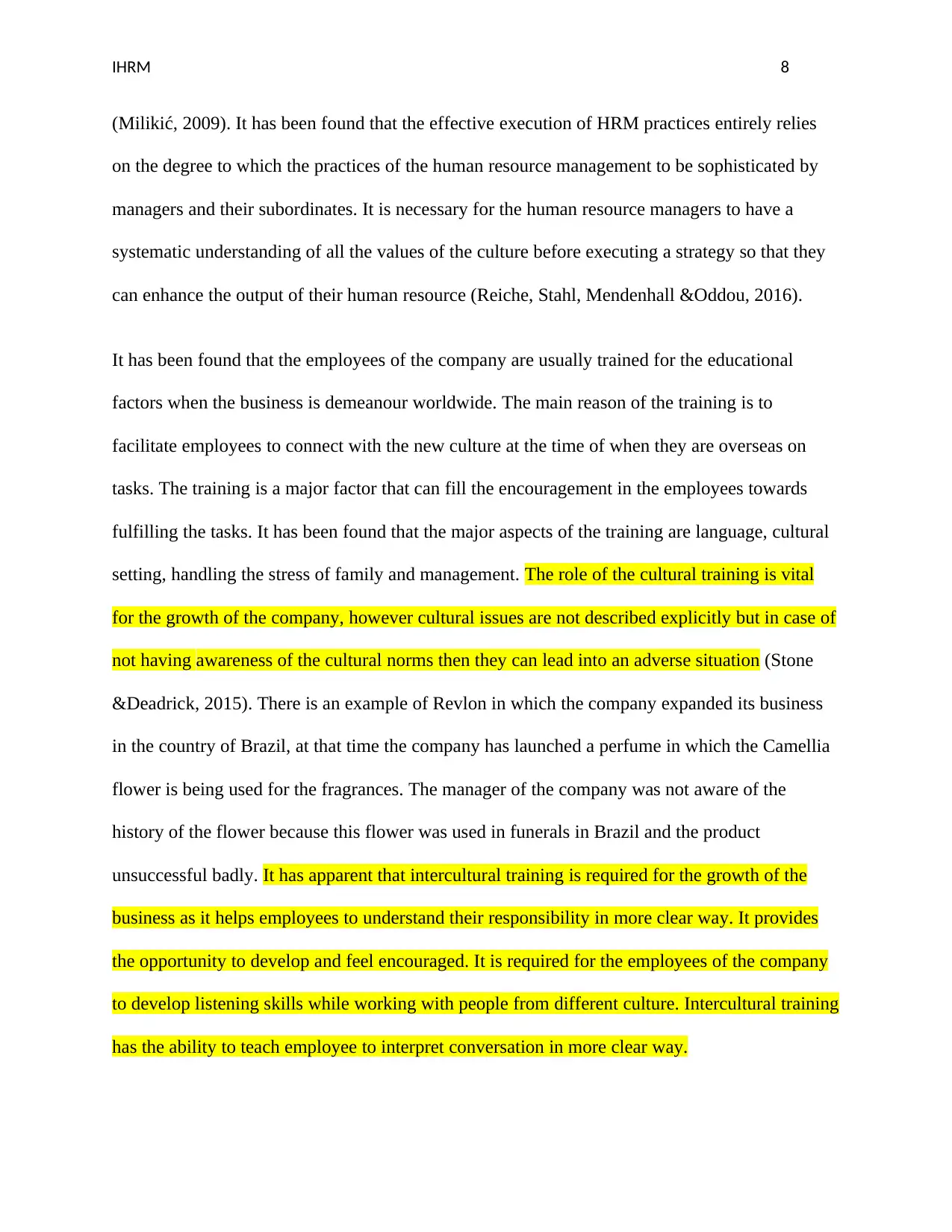
IHRM 8
(Milikić, 2009). It has been found that the effective execution of HRM practices entirely relies
on the degree to which the practices of the human resource management to be sophisticated by
managers and their subordinates. It is necessary for the human resource managers to have a
systematic understanding of all the values of the culture before executing a strategy so that they
can enhance the output of their human resource (Reiche, Stahl, Mendenhall &Oddou, 2016).
It has been found that the employees of the company are usually trained for the educational
factors when the business is demeanour worldwide. The main reason of the training is to
facilitate employees to connect with the new culture at the time of when they are overseas on
tasks. The training is a major factor that can fill the encouragement in the employees towards
fulfilling the tasks. It has been found that the major aspects of the training are language, cultural
setting, handling the stress of family and management. The role of the cultural training is vital
for the growth of the company, however cultural issues are not described explicitly but in case of
not having awareness of the cultural norms then they can lead into an adverse situation (Stone
&Deadrick, 2015). There is an example of Revlon in which the company expanded its business
in the country of Brazil, at that time the company has launched a perfume in which the Camellia
flower is being used for the fragrances. The manager of the company was not aware of the
history of the flower because this flower was used in funerals in Brazil and the product
unsuccessful badly. It has apparent that intercultural training is required for the growth of the
business as it helps employees to understand their responsibility in more clear way. It provides
the opportunity to develop and feel encouraged. It is required for the employees of the company
to develop listening skills while working with people from different culture. Intercultural training
has the ability to teach employee to interpret conversation in more clear way.
(Milikić, 2009). It has been found that the effective execution of HRM practices entirely relies
on the degree to which the practices of the human resource management to be sophisticated by
managers and their subordinates. It is necessary for the human resource managers to have a
systematic understanding of all the values of the culture before executing a strategy so that they
can enhance the output of their human resource (Reiche, Stahl, Mendenhall &Oddou, 2016).
It has been found that the employees of the company are usually trained for the educational
factors when the business is demeanour worldwide. The main reason of the training is to
facilitate employees to connect with the new culture at the time of when they are overseas on
tasks. The training is a major factor that can fill the encouragement in the employees towards
fulfilling the tasks. It has been found that the major aspects of the training are language, cultural
setting, handling the stress of family and management. The role of the cultural training is vital
for the growth of the company, however cultural issues are not described explicitly but in case of
not having awareness of the cultural norms then they can lead into an adverse situation (Stone
&Deadrick, 2015). There is an example of Revlon in which the company expanded its business
in the country of Brazil, at that time the company has launched a perfume in which the Camellia
flower is being used for the fragrances. The manager of the company was not aware of the
history of the flower because this flower was used in funerals in Brazil and the product
unsuccessful badly. It has apparent that intercultural training is required for the growth of the
business as it helps employees to understand their responsibility in more clear way. It provides
the opportunity to develop and feel encouraged. It is required for the employees of the company
to develop listening skills while working with people from different culture. Intercultural training
has the ability to teach employee to interpret conversation in more clear way.
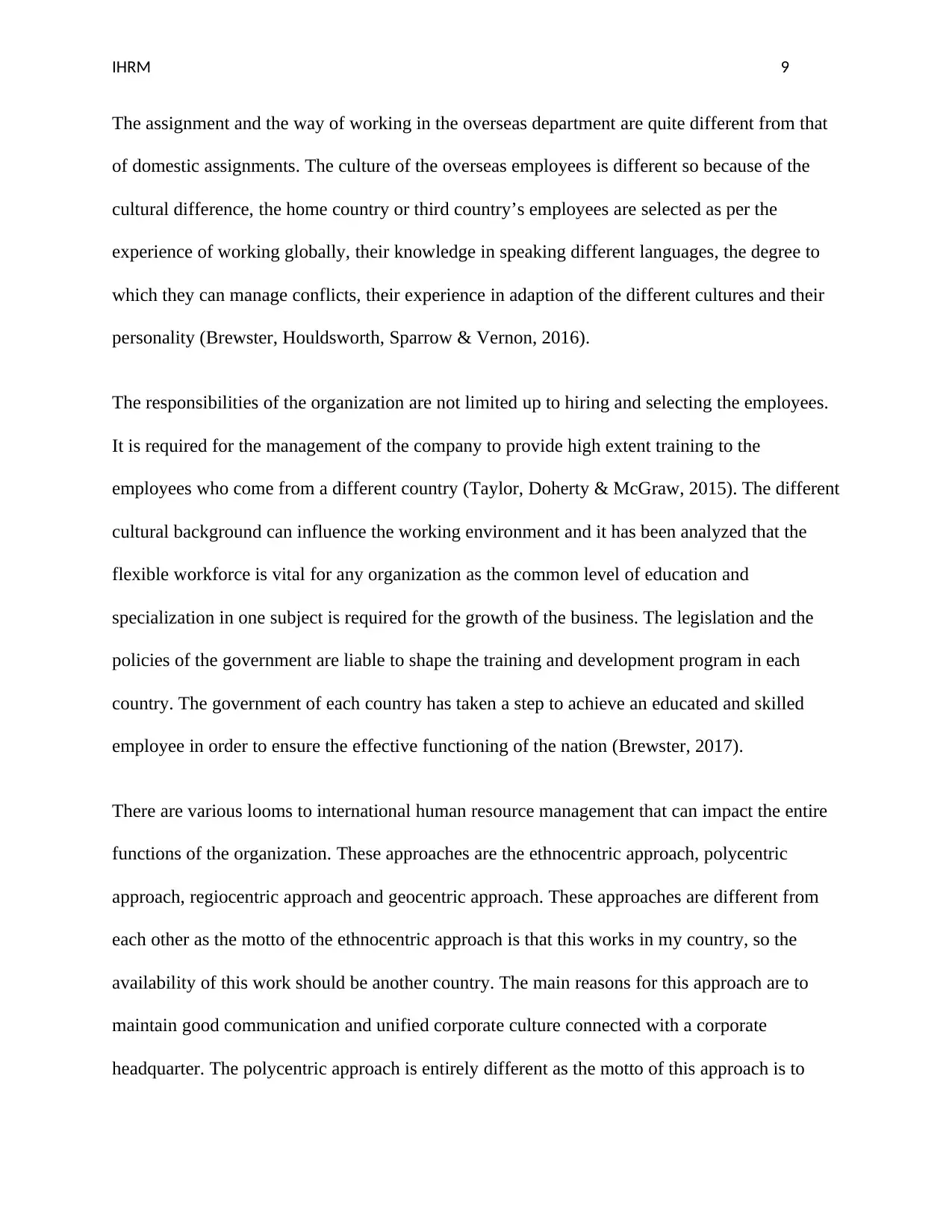
IHRM 9
The assignment and the way of working in the overseas department are quite different from that
of domestic assignments. The culture of the overseas employees is different so because of the
cultural difference, the home country or third country’s employees are selected as per the
experience of working globally, their knowledge in speaking different languages, the degree to
which they can manage conflicts, their experience in adaption of the different cultures and their
personality (Brewster, Houldsworth, Sparrow & Vernon, 2016).
The responsibilities of the organization are not limited up to hiring and selecting the employees.
It is required for the management of the company to provide high extent training to the
employees who come from a different country (Taylor, Doherty & McGraw, 2015). The different
cultural background can influence the working environment and it has been analyzed that the
flexible workforce is vital for any organization as the common level of education and
specialization in one subject is required for the growth of the business. The legislation and the
policies of the government are liable to shape the training and development program in each
country. The government of each country has taken a step to achieve an educated and skilled
employee in order to ensure the effective functioning of the nation (Brewster, 2017).
There are various looms to international human resource management that can impact the entire
functions of the organization. These approaches are the ethnocentric approach, polycentric
approach, regiocentric approach and geocentric approach. These approaches are different from
each other as the motto of the ethnocentric approach is that this works in my country, so the
availability of this work should be another country. The main reasons for this approach are to
maintain good communication and unified corporate culture connected with a corporate
headquarter. The polycentric approach is entirely different as the motto of this approach is to
The assignment and the way of working in the overseas department are quite different from that
of domestic assignments. The culture of the overseas employees is different so because of the
cultural difference, the home country or third country’s employees are selected as per the
experience of working globally, their knowledge in speaking different languages, the degree to
which they can manage conflicts, their experience in adaption of the different cultures and their
personality (Brewster, Houldsworth, Sparrow & Vernon, 2016).
The responsibilities of the organization are not limited up to hiring and selecting the employees.
It is required for the management of the company to provide high extent training to the
employees who come from a different country (Taylor, Doherty & McGraw, 2015). The different
cultural background can influence the working environment and it has been analyzed that the
flexible workforce is vital for any organization as the common level of education and
specialization in one subject is required for the growth of the business. The legislation and the
policies of the government are liable to shape the training and development program in each
country. The government of each country has taken a step to achieve an educated and skilled
employee in order to ensure the effective functioning of the nation (Brewster, 2017).
There are various looms to international human resource management that can impact the entire
functions of the organization. These approaches are the ethnocentric approach, polycentric
approach, regiocentric approach and geocentric approach. These approaches are different from
each other as the motto of the ethnocentric approach is that this works in my country, so the
availability of this work should be another country. The main reasons for this approach are to
maintain good communication and unified corporate culture connected with a corporate
headquarter. The polycentric approach is entirely different as the motto of this approach is to
⊘ This is a preview!⊘
Do you want full access?
Subscribe today to unlock all pages.

Trusted by 1+ million students worldwide
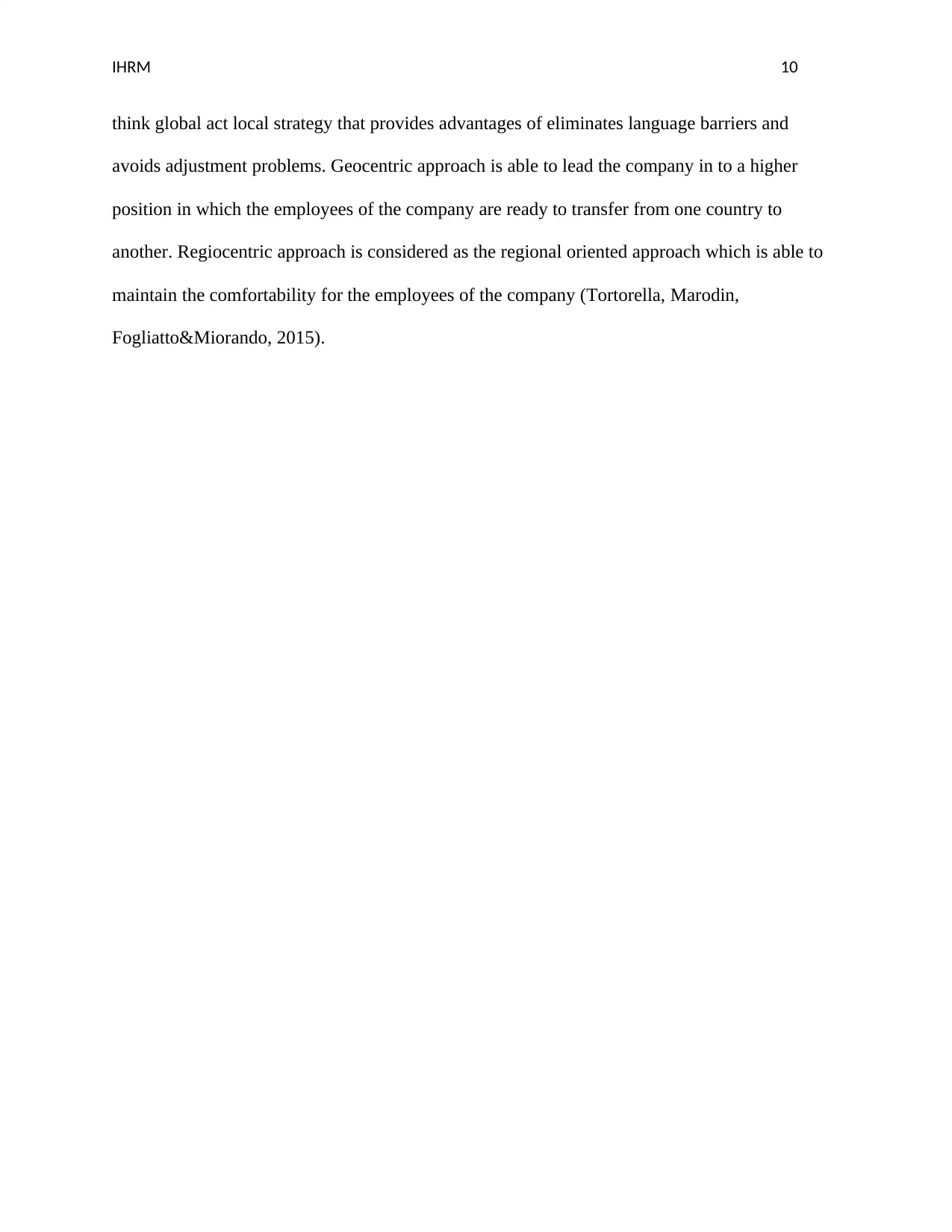
IHRM 10
think global act local strategy that provides advantages of eliminates language barriers and
avoids adjustment problems. Geocentric approach is able to lead the company in to a higher
position in which the employees of the company are ready to transfer from one country to
another. Regiocentric approach is considered as the regional oriented approach which is able to
maintain the comfortability for the employees of the company (Tortorella, Marodin,
Fogliatto&Miorando, 2015).
think global act local strategy that provides advantages of eliminates language barriers and
avoids adjustment problems. Geocentric approach is able to lead the company in to a higher
position in which the employees of the company are ready to transfer from one country to
another. Regiocentric approach is considered as the regional oriented approach which is able to
maintain the comfortability for the employees of the company (Tortorella, Marodin,
Fogliatto&Miorando, 2015).
Paraphrase This Document
Need a fresh take? Get an instant paraphrase of this document with our AI Paraphraser
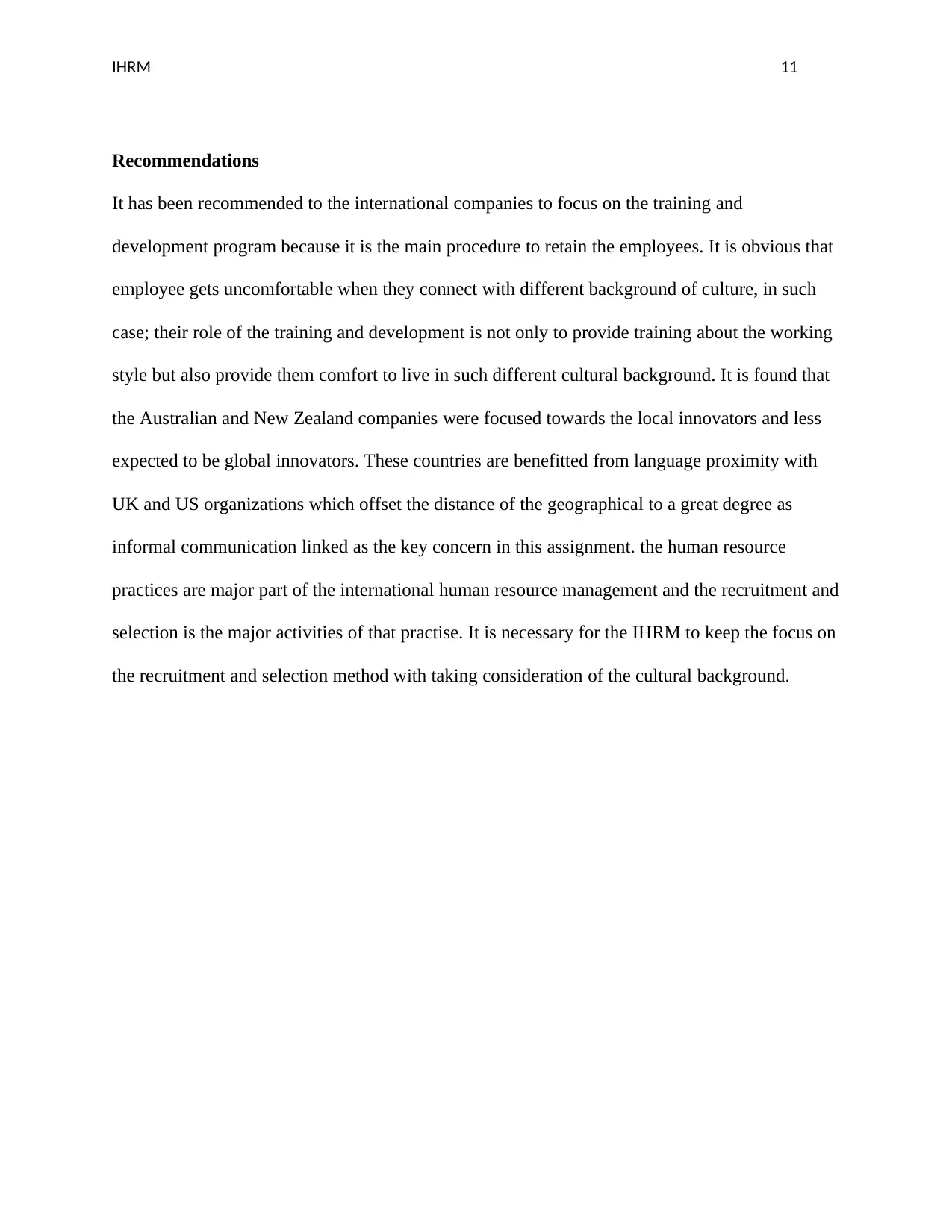
IHRM 11
Recommendations
It has been recommended to the international companies to focus on the training and
development program because it is the main procedure to retain the employees. It is obvious that
employee gets uncomfortable when they connect with different background of culture, in such
case; their role of the training and development is not only to provide training about the working
style but also provide them comfort to live in such different cultural background. It is found that
the Australian and New Zealand companies were focused towards the local innovators and less
expected to be global innovators. These countries are benefitted from language proximity with
UK and US organizations which offset the distance of the geographical to a great degree as
informal communication linked as the key concern in this assignment. the human resource
practices are major part of the international human resource management and the recruitment and
selection is the major activities of that practise. It is necessary for the IHRM to keep the focus on
the recruitment and selection method with taking consideration of the cultural background.
Recommendations
It has been recommended to the international companies to focus on the training and
development program because it is the main procedure to retain the employees. It is obvious that
employee gets uncomfortable when they connect with different background of culture, in such
case; their role of the training and development is not only to provide training about the working
style but also provide them comfort to live in such different cultural background. It is found that
the Australian and New Zealand companies were focused towards the local innovators and less
expected to be global innovators. These countries are benefitted from language proximity with
UK and US organizations which offset the distance of the geographical to a great degree as
informal communication linked as the key concern in this assignment. the human resource
practices are major part of the international human resource management and the recruitment and
selection is the major activities of that practise. It is necessary for the IHRM to keep the focus on
the recruitment and selection method with taking consideration of the cultural background.
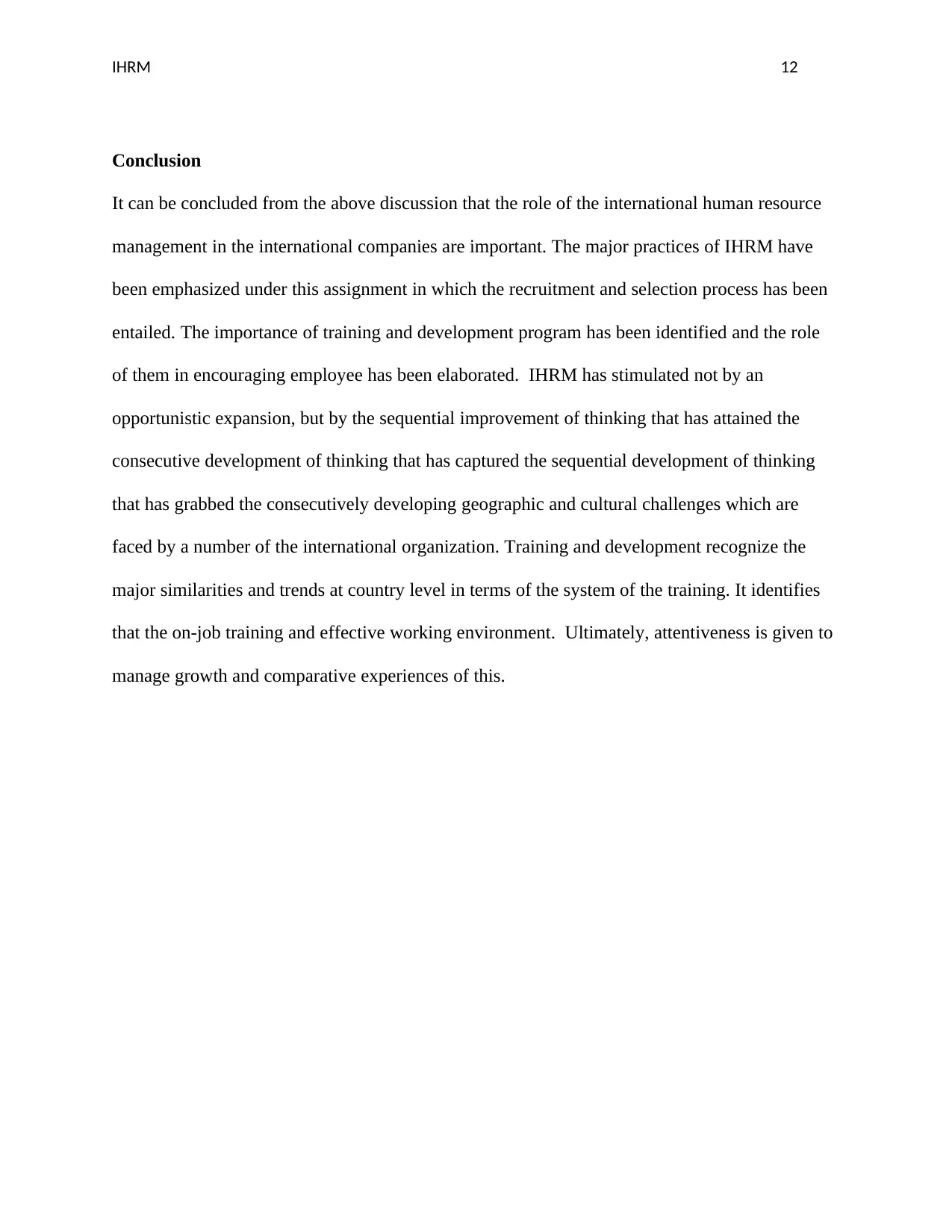
IHRM 12
Conclusion
It can be concluded from the above discussion that the role of the international human resource
management in the international companies are important. The major practices of IHRM have
been emphasized under this assignment in which the recruitment and selection process has been
entailed. The importance of training and development program has been identified and the role
of them in encouraging employee has been elaborated. IHRM has stimulated not by an
opportunistic expansion, but by the sequential improvement of thinking that has attained the
consecutive development of thinking that has captured the sequential development of thinking
that has grabbed the consecutively developing geographic and cultural challenges which are
faced by a number of the international organization. Training and development recognize the
major similarities and trends at country level in terms of the system of the training. It identifies
that the on-job training and effective working environment. Ultimately, attentiveness is given to
manage growth and comparative experiences of this.
Conclusion
It can be concluded from the above discussion that the role of the international human resource
management in the international companies are important. The major practices of IHRM have
been emphasized under this assignment in which the recruitment and selection process has been
entailed. The importance of training and development program has been identified and the role
of them in encouraging employee has been elaborated. IHRM has stimulated not by an
opportunistic expansion, but by the sequential improvement of thinking that has attained the
consecutive development of thinking that has captured the sequential development of thinking
that has grabbed the consecutively developing geographic and cultural challenges which are
faced by a number of the international organization. Training and development recognize the
major similarities and trends at country level in terms of the system of the training. It identifies
that the on-job training and effective working environment. Ultimately, attentiveness is given to
manage growth and comparative experiences of this.
⊘ This is a preview!⊘
Do you want full access?
Subscribe today to unlock all pages.

Trusted by 1+ million students worldwide
1 out of 16
Related Documents
Your All-in-One AI-Powered Toolkit for Academic Success.
+13062052269
info@desklib.com
Available 24*7 on WhatsApp / Email
![[object Object]](/_next/static/media/star-bottom.7253800d.svg)
Unlock your academic potential
Copyright © 2020–2025 A2Z Services. All Rights Reserved. Developed and managed by ZUCOL.




